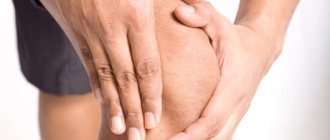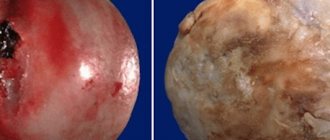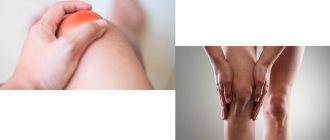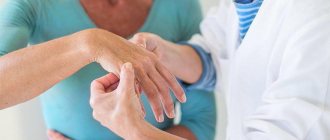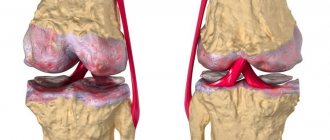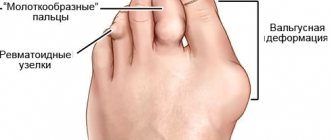When joint pain occurs, 90% of patients rush to the Internet for knowledge rather than to a rheumatologist. Such a desire for self-education is commendable as long as it does not result in self-diagnosis. Since arthritis of various etiologies and arthrosis have similar causes of occurrence, pain symptoms and similar localization, they are often confused. But after self-treatment, the complaints not only do not go away, but even intensify. The fact is that the difference between arthritis and arthrosis lies not only in different suffixes (where “-itis” means acute, sudden and rapidly developing inflammation, and “-oz” means a chronic, slowly growing disease).
Is the nature of arthritis and arthrosis the same or different?
Arthritis is an inflammatory process, most often associated with autoimmune diseases, previous infections, hormonal imbalances and metabolic factors that affect the general condition of the body. In this case, pathological changes occur in the joint fluid (whereas with arthrosis there is insufficient production of it) and connective tissue.
Inflammation usually manifests itself against the background of rheumatoid arthritis, starting from 25-30 years, or genitourinary, intestinal bacterial infections. The changes mainly affect the synovial membrane of the joint, where the blood vessels are concentrated.
Arthritis often causes complications in the heart, kidneys and liver, not limited to damage to the joints.
Arthrosis is a non-inflammatory degenerative disease that is associated with natural wear and tear of the joint surfaces. Thinning of cartilage can be caused by excessive loads, changes in hormonal levels, age-related changes in the patient's body, and disturbances in axial load (for example, with curvature of posture or improperly healed fractures).
Osteoarthritis is accompanied by decreased mobility in the joint and the formation of osteophytes. Unlike arthritis, it leads to mechanical local deformation of the joint capsule and bones, but does not affect other organs and systems. The disease attacks the entire cartilage. With arthrosis, inflammatory processes can also be observed, but they are not permanent and usually occur in the second and third stages of the disease.
Where the difference between arthritis and arthrosis is especially noticeable is the age of onset of the disease. The overwhelming number of patients with osteoarthritis are in the age category of 65 years or more, but the first symptoms can be observed at the age of 45 years. Arthritis affects young, able-bodied people under 55 years of age and can even occur in children and adolescents.
The most important thing about arthrosis
Arthrosis is a progressive disease that affects the articular surfaces. It develops gradually and leads to deformation and destruction of cartilage tissue. Various reasons lead to the disease: heredity, abnormalities in the structure of the joints, injuries, high loads. The pathology affects only the joints.
Typically, the disease affects mature and elderly people. It is also susceptible to those who, due to their occupation, place a lot of stress on the joints of the wrists, hands, and legs. You can sometimes hear arthrosis referred to as “pianists’ disease” or “athletes’ disease.”
Symptoms of arthrosis
Arthrosis appears gradually as it progresses. At the very beginning there are often no symptoms. Because of this, patients seek medical help in late stages, which makes treatment difficult.
First symptoms:
- crunching and clicking in joints;
- immobility of the joint after a long period of rest, quickly disappearing with movement;
- pain during exercise and movement.
As the disease progresses, the symptoms become more pronounced: immobility and pain intensify, and soft cartilage tissue is replaced by bone growths (the so-called hard joint syndrome). In later stages, patients may lose the ability to move the affected joints.
Treatment and prevention
If you “catch” arthrosis in the initial stage, then it responds well to therapy. Another important factor for prognosis is age. The younger the patient, the easier it is to rid him of the disease. What is the treatment?
In our center, shock wave therapy shows excellent results, when the restoration of joints is promoted by short-term exposure to low-frequency acoustic impulses. In addition, drug therapy that activates regeneration, electrophoresis with drugs, and carboxytherapy can be used. The load on sore joints is necessarily reduced.
Advanced disease and arthrosis in elderly patients cannot be completely cured. But with the help of regular, competent therapy, you can keep the disease under control, provide the patient with a high quality of life, and greatly slow down the destruction of the joint.
Basic principles of primary prevention, which helps prevent the development of arthrosis:
- maintain a normal weight - extra pounds increase the load on the joints;
- move - regular physical activity is good for joints;
- wear good and comfortable shoes - improper load distribution provokes increased pressure on the joints;
- strengthen immunity;
- don't get too cold.
Symptoms: how does arthritis differ from arthrosis in sensations?
The difference between arthritis and arthrosis is that arthritis begins with joint swelling, erythema (redness and warmth of the skin) and sharp pain that is not related to the intensity of movement. Painful sensations may even intensify at night (while arthrosis “subsides” after rest). There is often no crunch in arthritis. The pathological condition is usually provoked by stress, fatigue, colds, sore throat, cystitis and more. The course of an acute episode may be accompanied by:
- increased temperature;
- fever;
- enlargement of the joint due to swelling;
- loss of strength, increased fatigue;
- weight loss.
- Depending on the etiology:
- conjunctivitis;
- pain in the urinary tract;
- negative symptoms from organs with an active blood supply (heart, lungs, kidneys, liver).
The first sign of arthrosis is usually muscle discomfort, tension, and the appearance of a dull crunching sound in the joints. Morning stiffness and other signs may appear much later. Symptoms develop gradually, the disease is characterized by a sluggish nature - this is the main way arthrosis differs from arthritis. As it progresses, the following appears:
- reduction in range of motion;
- changing the contours of the joint;
- pain that gets worse after exercise.
Redness of the skin and paroxysmal character are not typical for arthrosis unless it is complicated by arthritis.
The nature of sensations during arthritis and arthrosis may be similar, but their mechanisms differ significantly. Thus, the classic symptoms of arthritis (swelling, pain, redness of the skin) are formed due to synovial effusion produced by the joint membrane during inflammation. Symptoms of arthritis are associated with mechanical damage to the articular surface and bone, the formation of bone spurs to distribute the decompensated load.
Localization: what is the difference between arthritis and arthrosis?
Both diseases can affect any joint, but in most cases the location of the pathology can indirectly indicate its nature. So, for example, arthritis has a so-called “affected joints” and “excluded joints” - depending on the prevalence of the disease.
Arthritis primarily affects:
- wrist and metacarpophalangeal joints;
- proximal interphalangeal joints;
- knee and ankle;
- metatarsophalangeal (in particular, the joints of the big toes);
- elbow joints.
The lesions can be either symmetrical (rheumatoid arthritis) or asymmetrical (psoriatic and other types).
Arthrosis selects load-bearing joints, which anatomically experience greater load. These include:
- knee:
- metacarpophalangeal joints of the thumbs;
- distal finger joints;
- hip;
- ankle;
- intervertebral.
Arthritis and arthrosis: symptoms and prevention
At first glance, arthrosis and arthritis are very similar, but these diseases differ significantly. What are the symptoms of these ailments and what prevention methods will help prevent the disease.
What is the difference between arthritis and arthrosis?
Both arthritis and arthrosis cause joint damage, but these are different diseases. If arthrosis affects only the joints, then arthritis implies an inflammatory process throughout the body. Inflammation can be caused by infection, abnormalities in the immune system, or metabolic disorders. Therefore, with this disease, not only joints, but also internal organs - liver, kidneys, heart - often suffer.
The age group in which the disease most often occurs also differs: arthritis usually manifests itself before the age of 40, while arthrosis mainly affects older people.
Symptoms of arthrosis and arthritis
- Pain
This is one of the main signs of arthrosis and arthritis, but the nature of pain in these diseases is different. Thus, with arthrosis, pain manifests itself mainly only with movement and strong additional load, while it may not be very strong (especially in the first stage of the disease). That is why people often do not attach importance to it, triggering the disease. In the second stage, pain appears even with a slight load, and in the third - even at rest. However, it may subside if the person manages to find a comfortable position.
But in the case of arthritis, the pain does not subside at rest. Night pain is especially characteristic of arthritis - between three and five o'clock in the morning.
- Crunch
Crunching with arthrosis occurs due to the fact that the cartilage layer is destroyed and bone friction occurs. However, if your joints sometimes crack, this is not a reason to panic. The crunch with arthrosis has a specific sound: it is not a light clicking sound, but a rough, dry one. The higher the stage, the stronger the crunch in the joint.
- Decreased mobility and stiffness
With arthrosis, the range of motion in the affected joint decreases. Arthritis is characterized by stiffness throughout the body or in a joint.
- Deformation
With arthrosis, the appearance of the joint changes, but in this case there is no swelling, as with arthritis. Symptoms of arthritis may include inflammation, swelling, the appearance of dense nodules, and increased temperature at the site of inflammation (it may feel hot to the touch).
With arthritis, inflammation of the joints can also be accompanied by:
- increased temperature;
- psoriasis;
- inflammation of the eyes (as if there is sand in the eyes);
- chills or excessive sweating;
- weakness;
- discharge from the genitals.
Prevention of arthritis and arthrosis
Moderate physical activity
Any moderate load helps reduce weight, increase blood circulation, strengthen the muscle corset, which is very important for the prevention of arthrosis and arthritis. However, it is important to be careful here: excessive stress on the joints, injuries or incorrect execution of certain exercises, on the contrary, can lead to problems. Therefore, at first it is necessary to conduct classes with a doctor or instructor. However, for prevention, you can perform so-called joint gymnastics - it is quite simple and does not require special equipment. Exercises in the pool are also good, since in water the load on the joints is much less.
Note!
We are talking specifically about the prevention of arthrosis and arthritis. If you have already been diagnosed with one of them, then you can only exercise after consulting a doctor (and in the acute period, training is completely contraindicated!) and only under the supervision of a general practitioner who will develop an individual training program for you.
Proper nutrition
It is also worth reconsidering your attitude to nutrition. To prevent arthrosis and arthritis, it is better to avoid red meat and foods high in fat. It’s good if your diet includes fish and seafood, vegetables and fruits. Cartilage and gelatin (for example, jellied meat) are also good for bones. Doctors also recommend increasing water consumption to 2-3 liters per day.
Avoid alcohol. You can start taking vitamins (groups A, D, B) and calcium.
Also, prevention of arthrosis and arthritis can be:
- protection of joints from hypothermia;
- wearing shoes with comfortable heels using individual orthopedic insoles;
- avoiding crossing legs while sitting;
- weight control;
- healthy lifestyle, rest and sleep patterns, avoidance of stress.
How does arthritis differ from arthrosis of the joints when diagnosed?
The primary diagnosis of arthritis and arthrosis involves visual examination and palpation of the joints that have become the source of complaints. Previous illnesses and injuries can also provide a clue.
A comprehensive blood and urine test can determine the difference between arthritis and arthrosis. It can determine the presence of bacterial pathogens, elevated white blood cell counts, rapid erythrocyte sedimentation, and other markers of inflammation (for example, rheumatoid factor. If the result is “clean,” other tests are prescribed.
An x-ray for arthrosis shows a narrowing of the joint space, thinning of the cartilage layer, and also, depending on the stage of the disease, the presence of osteophytes. With arthritis, no visible changes are noted.
Diagnosis can use hardware research methods (ultrasound, CT, MRI) and minimally invasive interventions (arthroscopy).
What is the difference between treating arthritis and arthrosis?
Let's start with the forecasts. Arthrosis is always incurable - it is a chronic disease and can only be contained. Arthritis can be either chronic (rheumatoid, idiopathic, psoriatic) or transient (infectious).
Let us take a closer look at the features and fundamental differences in the treatment of these diseases.
Arthritis treatment
You can get rid of infectious arthritis before the onset of destructive changes in the joint with timely treatment with antibiotics. The key role is played by the correct selection of the drug (for this you may have to take an antibiogram). In this case, due to self-medication, you can lose valuable time.
Rheumatoid arthritis requires lifelong treatment with corticosteroids, cytotoxic drugs and NSAIDs. Their use requires regular consultation with a doctor due to the negative impact on the body (especially if the dosage and duration of the course are not observed). New biological products demonstrate high efficiency - they reduce the severity of symptoms of the disease (pain and swelling).
If necessary, analgesics are prescribed - systemic or local. Complex therapy also includes diet, physiotherapy, and therapeutic exercises. If the disease has affected other organs, it is necessary to obtain advice from specialized specialists.
Treatment of arthrosis
In the early stages of arthrosis, drugs and physiotherapeutic techniques are extremely effective, which enhance regeneration, nutrition and moisture supply to the cartilage tissue. Regular use of chondroprotectors can significantly improve the quality of life at all stages of the disease, except the last.
Nonsteroidal anti-inflammatory drugs and corticosteroids are prescribed symptomatically to relieve inflammation and begin basic therapy. Analgesics are also used according to the same principle - usually local, in the form of gels and creams. As with arthritis, physical therapy and physiotherapy are indicated, but the techniques will differ. Optimal choice: electrophoresis, magnetic therapy, mud therapy and others.
What is the difference between the treatment of arthritis and arthrosis? The main emphasis is on the “restoration” of the cartilage capsule. However, in advanced cases, surgical treatment may be required, including joint replacement.
Symptoms of arthrosis of the knee joint
During the cold season, diseases such as arthrosis of the knee joint become especially noticeable. Cold is one of the factors in the manifestation and exacerbation of this disease. What should you pay attention to if you suspect you have arthrosis? First of all, you need to understand what arthrosis of the knee joint is. Arthrosis is a chronic damage to the joints, in which degenerative processes occur in the cartilage, causing its destruction. The main cause of this disease is premature wear of intra-articular cartilage. When cartilage tissue is destroyed, inflammation occurs somewhat later, so it does not always manifest itself symptomatically in the first stages. Simply put, the articular cartilage in the knee becomes thinner, and during movement the body is no longer able to cushion the periodic impacts of the body and, in particular, the knee joint.
In this case, there are such types of arthrosis as:
- Primary;
- Secondary.
In the first case, the disorders are associated with poor blood supply, as well as insufficient nutrition of the joint tissues. In the secondary form, the cause lies in other pathologies, or occurs as a complication of other types of diseases. As a rule, arthrosis (osteoarthrosis, osteoarthritis) is diagnosed in older people, but there are exceptions. The disease predominantly occurs in the female half of the population.
Stages of arthrosis
There are several stages of this disease:
- Stage 1 - at the first stage of the disease, a slight narrowing of the gap in the joint is observed, a sharpening of the edge of the articular surface occurs, and a mild restriction in movements is felt.
- Stage 2 – the narrowing of the gap intensifies, movement is significantly limited, and a strong crunch occurs in the knee. An osteophyte/cyst may appear.
- Stage 3 – deformation of the articular part of the knee occurs, movements are completely limited, compactions, subchondral cysts and osteophytes appear.
- Stage 4 – cartilage disappears from certain areas of the articular surface.
The main symptoms of arthrosis of the knee joint.
Among the main symptoms of arthrosis of the knee joint are the following:
- Severe and acute pain that appears in the knee bend area. The nature and intensity of painful sensations may change - as a rule, when moving, the pain is close to unbearable, and at rest it may seem weaker or even recede altogether.
- The appearance of edema in the damaged area, the manifestation of deformation.
- The appearance of a pronounced crunching sound when walking.
- Decreased joint mobility – the appearance of stiffness during movements, some limitation of leg mobility.
- Local inflammatory reaction, accompanied by severe swelling of the cartilage and a significant increase in its volume.
To maintain physical capacity, it is very important to diagnose osteoarthritis in the early stages. Accurate diagnosis is possible only on an outpatient basis, namely through arthroscopic examinations.
Diseases with similar symptoms:
Symptoms of arthrosis of the knee joint in some cases are similar to the symptoms of the following diseases:
- Tendon inflammation;
- Meniscopathy, as well as blockade of knee joints;
- Coxarthrosis;
- Arthritis.
Causes
There are many reasons that can contribute to the appearance of such a disease. Among them are:
- Injuries of various origins;
- Genetic predisposition to the appearance of osteoarthritis;
- Lack of collagen in the body;
- Metabolic disorders;
- Surgery to remove the meniscus;
- Excessive stress on the legs;
- Hypothermia of the legs;
- The appearance of excess weight, which can provoke increased stress on the knee joints;
- Joint diseases acquired during life.
Often this kind of disease occurs among former athletes, people who have experienced severe physical activity in the past. As for excessive fatness, it usually results in a bilateral form of arthrosis, while various injuries lead to a unilateral form of this disease.
Treatment of joint arthrosis.
After identifying signs of arthrosis of the knee joint, you should urgently consult a doctor - independent treatment may not only be ineffective, but also lead to negative consequences. In order not to provoke further development of the disease, before consulting a doctor, it is recommended not to overload yourself with physical activity, and, if possible, give your legs as much rest and rest as possible.
You can read more about arthrosis of the knee joint here.
